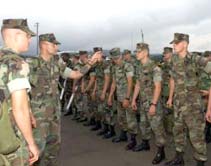|
Huge U.S. Military Buildup for Invasion Before Christmas
 |
|
The
Pentagon has plans for a lightning invasion of Iraq with up to
250,000 troops
|
WASHINGTON,
November 12 (IslamOnline & News Agencies) – U.S. President George
W. Bush braced
the United States for war against Iraq if the United Nations does not
take a decision on military action, among reports of a huge military
buildup for what is seen as an "inevitable" strike.
"I
will commit the full force and might of the United States military and
we will prevail," he told veterans
at a special White House reception Monday, November 11, Agence
France-Presse (AFP) reported.
As
senior Bush aides
espouse a "zero-tolerance" policy on Iraq, major U.S.
newspapers reported over the weekend that the Pentagon has plans for a
lightning invasion of Iraq with up to 250,000 troops.
Quoting
senior U.S. officials, The Washington Post and The New
York Times said the plan envisioned a lightning strike by land, sea
and air forces in the hope of toppling Iraqi President Saddam Hussein's
regime.
However,
Bush’s National
Security Adviser Condoleezza Rice said a tough new U.N. resolution aimed
at disarming Iraq does not bring the world "closer to war",
but that the threat of violence is the only useful tool for cowing
Baghdad.
"We
have to keep in a sense a gun pointed to the head of the Iraqi regime
because that's the only way that they cooperate," she told NPR
Radio, in an interview to be aired Tuesday, November 12.
The
Iraqi president must now comply "unequivocally and without any
reservation" or face war, she said.
The
British daily newspaper, The Independent, meanwhile, reported
Tuesday that U.S. administration officials said a war against Iraq could
begin before the end of the year.
U.S.
Secretary of State Colin Powell told
CNN: "We're not going to wait until February to see whether Iraq is
co-operating or not."
The
war would begin with an aerial bombardment, shorter but more precise and
even more intense than the month-long bombing that kicked off Operation
Desert Storm in January 1991, said The Independent.
The
onslaught would begin against "regime targets" concentrated on
Baghdad and the central parts of the country, and American and British
forces would seize the northern, western and southern sections of Iraq,
it added.
More
than 50,000 American troops are already in the Middle East. Two
additional aircraft carrier groups are on their way while heavy
equipment is being shipped in by chartered freighter.
The
overall effect is to reinforce the sense that war is inevitable whatever
happens with the inspections. Iraq, it is implied, will be subjected to
what Pentagon planners call "total spectrum warfare", which
employs multiple tactics.
According
to U.S. planners, this strategy is intended to prevent Iraq from firing
its missiles, possibly with chemical and biological warheads, at Israel.
It will also provide the attacking U.S. with forward bases to attack the
central stronghold of the regime and bypass a reluctant Saudi Arabia as
well as Jordan and, possibly, Turkey.
No
problems are likely in the predominantly Kurdish north, which is already
largely autonomous and guarded by a no-fly zone policed by U.S. and
British war planes (and not sanctioned by any U.N. resolution). Much the
same goes for the south, populated by Shiite Muslims with a long history
of resistance to President Saddam.
According
to the Post, U.S. troops from the 101st Air Force Division
and comparable British units would move into northern Iraq, also to
prevent Iraqi forces retreating there. The plan calls for U.S. marines
and British forces to seize airstrips around the port of Basra in the
south. Of the total allied forces deployed, "several thousand"
would be British, the only non-U.S. contribution on the ground.
The
initial attack would be accompanied by intense psychological "psy
ops", measures to incite Iraqi commanders to defect and to assure
civilians that the war is not directed at them.
Pentagon
planners reckon that President Saddam might be toppled by a coup. If not
he might face a multi-pronged armored attack from the north, south and
west towards Baghdad. If the resistance continues, the Bush
administration's nightmare could materialize – street-by-street
fighting for the Iraqi capital, in which heavy civilian casualties would
be almost inevitable. For that purpose, the biggest force available is
said to be between 200,000 and 250,000 men, roughly half the size of the
force assembled to drive Iraq from Kuwait 11 years ago.
General
Tommy Franks, the head of U.S. Central Command, and his military
colleagues have prevailed over civilian officials who believed that a
less orthodox "inside out'' war, which struck the regime at its
heart at the outset, could do the job just as well with much smaller
forces. "This is a classic Army/Tommy Franks plan. It's their game
plan,'' a former general said.

|